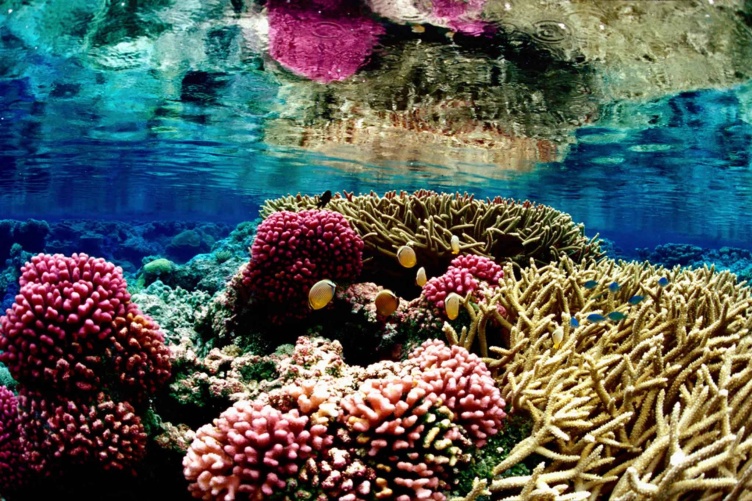
Photo credit: Jim E Maragos, U.S. Fish and Wildlife Service
Tropical corals are in hot water. As the ocean heats up, corals are slowly migrating away from the equator and finding refuge in cooler waters at higher latitudes — but in the coming decades, the ocean will likely warm faster than a lot of the reefs can relocate, a new study indicates.
The study, which was published in the journal Science Advances, was led by researchers at the University of Hawai’i in collaboration with UNH and the Victoria University of Wellington. The researchers found that there will likely be a ‘timescale mismatch’ between coral reef decline versus their range expansion. Because of that, the study estimates that the most severe declines in coral cover could take place within the next 40-80 years if there are no improvements in the limitation of greenhouse gas emissions contributing to ocean warming.
"Anything we can do to slow down the rate of ocean warming will make it more likely the corals can shift to places where it's more amenable for them to survive."
However, there are areas around the globe that could experience a modest amount of coral reef expansion, including Australia, Japan, Florida and the Bahamas, according to the research findings. The study also found that limiting greenhouse gas emissions could significantly blunt the damage to corals.
“Anything we can do to slow down the rate of ocean warming will make it more likely the corals can shift to places where it’s more amenable for them to survive,” says James Pringle, UNH professor of Earth sciences who is a co-author on the study.
Corals don't migrate in the same way that a swiftly swimming fish such as a bluefin tuna will. A tuna can swim thousands of kilometers to seek their preferred temperatures. Corals do not swim; instead, in their young larval life stage, they passively float with ocean currents for a day, a week, or maybe even for a few months, until they settle in a new spot. If the currents, like the Gulf Stream, are flowing toward colder waters, these corals have a better shot at survival than if they had remained in their too-toasty native tropical waters. Still, it’s a rather slow process to rebuild a coral reef in a new location: Scientists estimate that it could take close to a century or more for wide-scale re-establishment. And corals might not have that kind of time available to them, researchers say.
To take a closer look at coral larval transport, the research team relied on technology previously developed by Pringle. With funding from the National Science Foundation, Pringle created a publicly available tool called EZFate, which can predict where a particle — or in this case, coral larvae — located anywhere in the ocean will travel and end up based on the surrounding currents.
“You don’t need a supercomputer or have a Ph.D. in oceanography to utilize it,” Pringle notes, which makes EZFate it a lot more accessible to a wider swath of scientists.
Researchers at the University of Hawai’i used EZFate to help develop a population model to study the shifts in coral population in the face of warming ocean waters. They ran the model under three different ocean temperature scenarios based on global scientific consensus for future greenhouse gas emission forecasts: low ocean warming at 2 degrees Celsius by the year 2100; moderate warming at 3 degrees Celsius; and high warming at more than 4 degrees Celsius.
The high warming scenario would likely occur if there were no additional efforts made to curb greenhouse gas emissions, Pringle explained. Under this scenario, the timescale mismatch is the most pronounced, leading to widespread coral die-offs. Under the low ocean warming scenario, corals are likely to experience 25-34 percent declines.
Despite this potentially dire outlook for many corals, Pringle says there’s still reason for hope. Corals are more resilient to increasing water temperatures if they aren’t facing other pressures like pollution and overfishing, so decreasing or eliminating those additional stressors could mean the difference between ‘tolerable’ versus catastrophic declines in coral reef cover, even if future greenhouse gas emissions continue their current trajectory.
Pringle also notes that models and tools like EZFate can sometimes underpredict dispersal of an organism; that is, the coral might be able to float further than we expect for a variety of reasons. If that’s the case, then it’s possible the Gulf Stream could bring Caribbean corals up the Atlantic seaboard to settle off the coast of northern New England — and if they survive the winter, that’s even better news.
This research was funded by NOAA through University Corporation for Atmospheric Research’s Cooperative Programs for the Advancement of Earth System Science, and through support from the National Science Foundation.
-
Written By:
Rebecca Irelan | Institute for the Study of Earth, Oceans, and Space | rebecca.irelan@unh.edu | 603-862-0990

















































